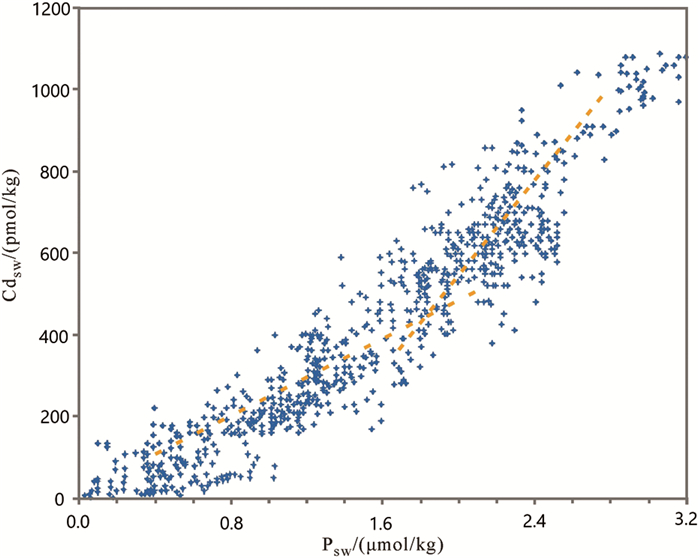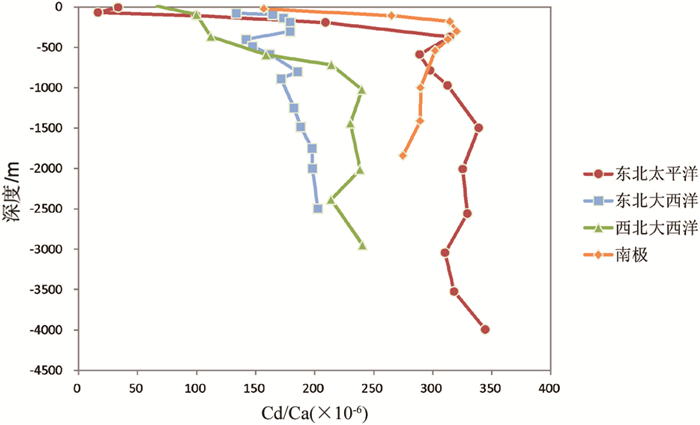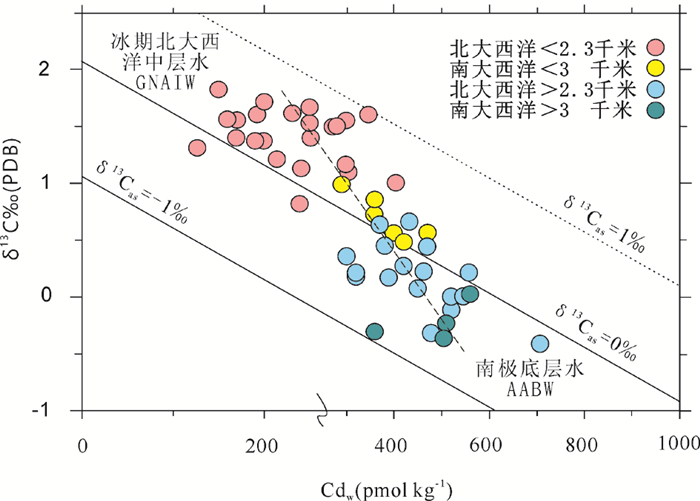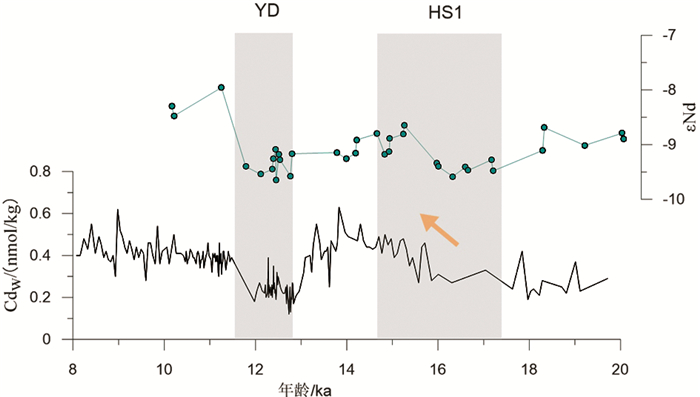Hydrochemical behaviors of Cd in paleoceans and a review of Cd/Ca ratio in foraminifera shells as a paleoeanographyic proxy
-
摘要:
Cd元素是一种较为特殊的微量金属元素,其在海水中的浓度分布和P类似,且和P之间存在着线性关系,因此,可以用来恢复古海水的营养水平,并可进一步结合有孔虫壳体的碳同位素记录,得出不同水团在海气交换过程中的同位素变化,用以示踪水团来源。同时,Cd含量本身也是水团的保守参数,因而也可以反映水团混合和洋流模式的改变。有孔虫壳体对Cd元素的吸收使得其Cd/Ca成为海水Cd含量的记录者,无论在构造尺度、轨道尺度,还是在千年尺度上,有孔虫壳体的Cd/Ca对气候和洋流变化均有着清晰的响应,是一种重要的古海洋环境替代性指标。不过由于Cd、P并非完全线性相关,钙质壳体在不同环境下对Cd的吸收比例不同,各海区在重要地质时期的Cd/Ca数据尚不丰富,使得Cd/Ca比值作为一种古环境参数仍面临着诸多挑战。
Abstract:As an element sharing linier distribution relation with phosphorous in the ocean, cadmium has great potential to be a proxy for reconstruction of the concentration of labile nutrient during geological history. Further it could be used to trace the water source by calculating the isotope equilibrium caused by the water-atmosphere exchange when connected with the carbon isotope of foraminifera. Also, the concentration of cadmium, as a conservative attribute of water mass, remains considerably constant, thus its variation could record the changes in water mass mixing and the pattern of ocean circulation. The cadmium uptake during the crystallization of foraminifera makes its Cd/Ca ratio a reliable recorder of the concentration variability of cadmium in the sea over the tectonic, orbital and the millennial scales. Because the linear dependence between cadmium and phosphorous is not so perfect and the absorption ratio of cadmium in calcareous shells also changes through different circumstances, and the records has not been adequate for reference, challenge still remains for Cd/Ca as a reliable paleoenvironmental proxy.
-
Key words:
- Cd/Ca /
- Cd /
- δ13C /
- ocean circulation
-

-
图 1 全球大洋溶解Cd和P(PO43-)的关系(据文献[18])
Figure 1.
-
[1] Sarnthein M, Winn K, Jung S J A, et al. Changes in East Atlantic Deepwater Circulation over the last 30, 000 years: Eight time slice reconstructions[J]. Paleoceanography, 1994, 9(2):209-267. doi: 10.1029/93PA03301
[2] Slowey N C, Curry W B. Glacial-interglacial differences in circulation and carbon cycling within the upper western North Atlantic[J]. Paleoceanography, 1995, 10(4):715-732. doi: 10.1029/95PA01166
[3] Zheng X Y, Jenkyns H C, Gale A S, et al. Changing ocean circulation and hydrothermal inputs during Ocean Anoxic Event 2 (Cenomanian-Turonian): Evidence from Nd-isotopes in the European shelf sea[J]. Earth & Planetary Sciences Letters, 2013, 375(8):338-348. http://d.old.wanfangdata.com.cn/NSTLQK/NSTL_QKJJ0231075592/
[4] Dera G, Prunier J, Smith P L, et al. Nd isotope constraints on ocean circulation, paleoclimate, and continental drainage during the Jurassic breakup of Pangea[J]. Gondwana Research, 2015, 27(4):1599-1615. doi: 10.1016/j.gr.2014.02.006
[5] Wei R, Abouchami W, Zahn R, et al. Deep circulation changes in the South Atlantic since the Last Glacial Maximum from Nd isotope and multi-proxy records[J]. Earth & Planetary Science Letters, 2016, 434:18-29. http://www.wanfangdata.com.cn/details/detail.do?_type=perio&id=af8f0e2c62a331367c0b7aaa932e2653
[6] Marchal O, François R, Stocker T F, et al. Ocean thermohaline circulation and sedimentary 231Pa/230Th ratio[J]. Paleoceanography, 2000, 15(6):625-641. doi: 10.1029/2000PA000496
[7] Mcmanus J F, Francois R, Gherardi J M, et al. Collapse and rapid resumption of Atlantic meridional circulation linked to deglacial climate changes[J]. Nature, 2004, 428(6985):834. doi: 10.1038/nature02494
[8] Valley S, Lynch-Stieglitz J, Marchitto T M. Timing of Deglacial AMOC Variability from a High-resolution Seawater Cadmium Reconstruction[J]. Paleoceanography, 2017, 32(11). https://agupubs.onlinelibrary.wiley.com/doi/abs/10.1002/2017PA003099
[9] Delaney M L, Boyle E A. Cd/Ca in late Miocene benthic foraminifera and changes in the global organic carbon budget[J]. Nature, 1987, 330(6144):156-159. doi: 10.1038/330156a0
[10] Jr T M M, Oppo D W, Curry W B. Paired benthic foraminiferal Cd/Ca and Zn/Ca evidence for a greatly increased presence of Southern Ocean Water in the glacial North Atlantic[J]. Paleoceanography, 2002, 17(3):10-1-10-18. http://www.wanfangdata.com.cn/details/detail.do?_type=perio&id=10.1029/2000PA000598
[11] Rosenthal Y, Boyle E A, Labeyrie L, et al. Glacial enrichments of authigenic Cd And U in subantarctic sediments: A climatic control on the elements' oceanic budget?[J]. Paleoceanography, 1995, 10(3):395-413. doi: 10.1029/95PA00310
[12] Jr T M M, Curry W B, Oppo D W. Zinc concentrations in benthic foraminifera reflect seawater chemistry[J]. Paleoceanography, 2000, 15(3):299-306. doi: 10.1029/1999PA000420
[13] Marchitto T M, Ortiz J, Carriquiry J, et al. A 14, 000 year foraminiferal trace metal record of ENSO-influenced upwelling near southern Baja California[C]// AGU Fall Meeting, 2005.
[14] Palmer M R, Brummer G J, Cooper M J, et al. Multi-proxy reconstruction of surface water pCO2, in the northern Arabian Sea since 29 ka[J]. Earth & Planetary Science Letters, 2010, 295(1-2):49-57. http://www.wanfangdata.com.cn/details/detail.do?_type=perio&id=edda7ae4357127c577e9ae50a1d295bb
[15] Xie R C, Galer S J G, Abouchami W, et al. The cadmium-phosphate relationship in the western South Atlantic — The importance of mode and intermediate waters on the global systematics[J]. Marine Chemistry, 2015, 177:110-123. doi: 10.1016/j.marchem.2015.06.011
[16] Boyle E A, Sclater F, Edmond J M. On the marine geochemistry of cadmium[J]. Nature, 1976, 263(5572):42-44. doi: 10.1038/263042a0
[17] Boyle E A. Cadmium: Chemical tracer of deepwater paleoceanography[J]. Paleoceanography, 1988, 3(4):471-489. doi: 10.1029/PA003i004p00471
[18] Elderfield H, Rickaby R E. Oceanic Cd/P ratio and nutrient utilization in the glacial Southern Ocean[J]. Nature, 2000, 405(6784):305. doi: 10.1038/35012507
[19] Nozaki Y, Yamada M, Nakanishi T, et al. The distribution of radionuclides and some trace metals in the water columns of the Japan and Bonin trenches[J]. Oceanologica Acta, 1998, 21(3):469-484. doi: 10.1016/S0399-1784(98)80031-5
[20] Quay P, Cullen J, Landing W, et al. Processes controlling the distributions of Cd and PO4 in the ocean[J]. Global Biogeochemical Cycles, 2015, 29(6):830-841. doi: 10.1002/2014GB004998
[21] Price N M, Morel F M M. Cadmium and cobalt substitution for zinc in a marine diatom[J]. Nature, 1990, 344(6267):658-660. doi: 10.1038/344658a0
[22] Morel F M M, Reinfelder J R, Roberts S B, et al. Zinc and carbon co-limitation of marine phytoplankton[J]. Nature, 1994, 369(6483):740-742. doi: 10.1038/369740a0
[23] Morel F M M, Milligan A J, Saito M A. 6.05-marine bioinorganic chemistry: the role of trace metals in the oceanic cycles of major nutrients[J]. Treatise on Geochemistry, 2003, 6:113-143. https://www.sciencedirect.com/science/article/pii/B0080437516061089
[24] Lane T W, Morel F M. A biological function for cadmium in marine diatoms[J]. Proceedings of the National Academy of Sciences of the United States of America, 2000, 97(9):4627. doi: 10.1073/pnas.090091397
[25] Lee J G, Morel F. Replacement of zinc by cadmium in marine phytoplankton[J]. Marine Ecology Progress, 1995, 127(1):305-309. http://d.old.wanfangdata.com.cn/NSTLQK/10.3354-meps127305/
[26] Cullen J T, Lane T W, Franç, et al. Modulation of cadmium uptake in phytoplankton by seawater CO2 concentration[J]. Nature, 1999, 442(6758):1025-1028. http://d.old.wanfangdata.com.cn/NSTLQK/10.1038-46469/
[27] Rijkenberg M J, Middag R, Laan P, et al. The distribution of dissolved iron in the West Atlantic Ocean.[J]. Plos One, 2014, 9(6):e101323. doi: 10.1371/journal.pone.0101323
[28] Pagani M, Freeman K H, Ohkouchi N, et al. Comparison of water column [CO2aq] with sedimentary alkenone-based estimates: A test of the alkenone-CO2 proxy[J]. Paleoceanography, 2002, 17(4):21-1-21-12. https://agupubs.onlinelibrary.wiley.com/doi/full/10.1029/2002PA000756
[29] Frew R D, Hunter K A. Influence of Southern Ocean waters on the cadmium-phosphate properties of the global ocean[J]. Nature, 1992, 360(6400):144-146. doi: 10.1038/360144a0
[30] Cullen J T. On the nonlinear relationship between dissolved cadmium and phosphate in the modern global ocean: could chronic iron limitation of phytoplankton growth cause the kink?[J]. Limnology & Oceanography, 2006, 51(3):1369-1380. https://www.jstor.org/stable/3841183
[31] Frew R, Bowie A, Croot P, et al. Macronutrient and trace-metal geochemistry of an in situ iron-induced Southern Ocean bloom[J]. Deep Sea Research Part Ⅱ Topical Studies in Oceanography, 2001, 48(11-12):2467-2481. doi: 10.1016/S0967-0645(01)00004-2
[32] Finkel Z V, Quigg A S, Chiampi R K, et al. Phylogenetic diversity in cadmium : phosphorus ratio regulation by marine phytoplankton[J]. Limnology & Oceanography, 2007, 52(3):1131-1138. https://www.jstor.org/stable/4499683
[33] Abouchami W, Galer S J G, Baar H J W D, et al. Modulation of the Southern Ocean cadmium isotope signature by ocean circulation and primary productivity[J]. Earth & Planetary Science Letters, 2011, 305(1-2):83-91. http://www.wanfangdata.com.cn/details/detail.do?_type=perio&id=6c92b9ff7045b10b3643deab6cba7ad2
[34] Abouchami W, Galer S J G, Baar H J W D, et al. Biogeochemical cycling of cadmium isotopes in the Southern Ocean along the Zero Meridian[J]. Geochimica Et Cosmochimica Acta, 2014, 127(3):348-367. http://www.wanfangdata.com.cn/details/detail.do?_type=perio&id=3429a4f7caecbbaeec2b71a848d72c9a
[35] Flegal A R, Yeats P A, Westerlund S. Cadmium, copper and nickel distributions at 4 stations in the eastern central and south Atlantic[J]. Marine Chemistry, 1995, 49(4):283-293. doi: 10.1016/0304-4203(95)00018-M
[36] Geen A V, Mccorkle D C, Klinkhammer G P. Sensitivity of the phosphate-cadmium-carbon isotope relation in the ocean to cadmium removal by suboxic sediments[J]. Paleoceanography, 1995, 10(2):159-169. doi: 10.1029/94PA03352
[37] Broecker W S, Peng T H. Tracers in the Sea[M]. Eldigio, Palisades, New York, 1982.
[38] Walsh R S, Hunter K A. Influence of phosphorus storage on the uptake of cadmium by the marine alga Macrocystis pyrifera[J]. Limnology & Oceanography, 1992, 37(7):1361-1369. http://www.wanfangdata.com.cn/details/detail.do?_type=perio&id=10.4319/lo.1992.37.7.1361
[39] Bruland K W. Oceanographic distributions of cadmium, zinc, nickel, and copper in the North Pacific[J]. Earth & Planetary Science Letters, 1980, 47(2):176-198. https://www.sciencedirect.com/science/article/pii/0012821X80900357
[40] Martin J H, Gordon R M, Fitzwater S E. Iron in Antarctic waters[J]. Nature, 1990, 345(6271):156-158. doi: 10.1038/345156a0
[41] Bruland K W. Manganese, nickel, copper, zinc and cadmium in the western north Atlantic.P[J]. Trace Metals in Sea Water, 1983, 4.
[42] Baar H J W D, Saager P M, Nolting R F, et al. Cadmium versus phosphate in the world ocean[J]. Marine Chemistry, 1994, 46(3):261-281. doi: 10.1016/0304-4203(94)90082-5
[43] Broecker W S, Maier-Reimer E. The influence of air and sea exchange on the carbon isotope distribution in the sea[J]. Global Biogeochemical Cycles, 1992, 6(3):315-320. doi: 10.1029/92GB01672
[44] Lynch-Stieglitz J, Geen A V, Fairbanks R G. Interocean exchange of glacial North Atlantic Intermediate Water: Evidence from subantarctic Cd/Ca and carbon isotope measurements[J]. Paleoceanography, 1996, 11(2):191-201. doi: 10.1029/95PA03772
[45] Marchitto T M, Broecker W S. Deep water mass geometry in the glacial Atlantic Ocean: A review of constraints from the paleonutrient proxy Cd/Ca[J]. Geochemistry Geophysics Geosystems, 2006, Q12003. https://agupubs.onlinelibrary.wiley.com/doi/full/10.1029/2006GC001323
[46] Chappell J. Upper Quaternary warping and uplift rates in the Bay of Plenty and west coast, North Island, New Zealand[J]. New Zealand Journal of Geology & Geophysics, 1975, 18(1):129-154. https://www.tandfonline.com/doi/abs/10.1080/00288306.1975.10426351
[47] Boyle E A. Cadmium and delta 13C paleochemical ocean distributions during the stage 2 glacial maximum[J]. Annual Review of Earth & Planetary Sciences, 1992, 20(1):245-287. https://www.annualreviews.org/doi/abs/10.1146/annurev.ea.20.050192.001333?journalCode=earth
[48] Ohkouchi N, Kawahata H, Okada M, et al. Benthic foraminifera cadmium record from the western equatorial Pacific[J]. Marine Geology, 1995, 127(1):167-180. https://www.sciencedirect.com/science/article/abs/pii/002532279500009N
[49] Mccorkle D C, Martin P A, Lea D W, et al. Evidence of a dissolution effect on benthic foraminiferal shell chemistry: δ13C, Cd/Ca, Ba/Ca, and Sr/Ca results from the Ontong Java Plateau[J]. Paleoceanography, 1995, 10(4):699-714. doi: 10.1029/95PA01427
[50] Boyle E, Rosenthal Y. Chemical Hydrography of the South Atlantic During the Last Glacial Maximum: Cd vs. δ 13 C[M]// The South Atlantic. Springer Berlin Heidelberg, 1996: 423-443.
[51] Boyle E A, Labeyrie L, Duplessly J C. Calcitic foraminiferal data confirmed by cadmium in aragonitic Hoeglundina : Application to the Last Glacial Maximum in the northern Indian Ocean[J]. Paleoceanography, 1995, 10(5):881-900. doi: 10.1029/95PA01625
[52] Marchitto T M. Lack of a significant temperature influence on the incorporation of Cd into benthic foraminiferal tests[J]. Geochemistry Geophysics Geosystems, 2004, 5(10). http://www.wanfangdata.com.cn/details/detail.do?_type=perio&id=10.1029/2004GC000753
[53] Rickaby R E M, Elderfield H. Planktonic foraminiferal Cd/Ca: Paleonutrients or paleotemperature?[J]. Paleoceanography, 1999, 14(3):293-303. doi: 10.1029/1999PA900007
[54] Boyle E A, Keigwin L. North Atlantic thermohaline circulation during the past 20, 000 years linked to high-latitude surface temperature[J]. Nature, 1987, 330(6143):35-40. doi: 10.1038/330035a0
[55] Xie R C, Marcantonio F, Schmidt M W. Deglacial variability of Antarctic Intermediate Water penetration into the North Atlantic from authigenic neodymium isotope ratios[J]. Paleoceanography, 2012, 27(3), PA3221. http://www.wanfangdata.com.cn/details/detail.do?_type=perio&id=10.1029/2012PA002337
[56] Lynch-Stieglitz J, Schmidt M W, Curry W B. Evidence from the Florida Straits for Younger Dryas ocean circulation changes[J]. Paleoceanography, 2011, 26(1). http://www.wanfangdata.com.cn/details/detail.do?_type=perio&id=10.1029/2010PA002032
[57] Marchitto T M, Curry W B, Oppo D W. Millennial-scale changes in North Atlantic circulation since the last glaciation[J]. Nature, 1998, 393(393):557-561. http://d.old.wanfangdata.com.cn/NSTLQK/10.1038-31197/
[58] Sarnthein M, Winn K, Jung S J A, et al. Changes in East Atlantic Deepwater Circulation over the last 30, 000 years: Eight time slice reconstructions[J]. Paleoceanography, 1994, 9(2):209-267. doi: 10.1029/93PA03301
-




 下载:
下载:


